If you’re new to cooking with tofu or you’ve been underwhelmed by it in the past, you may be asking yourself, “How do you actually make tofu taste good?” Keep scrolling and you’ll learn not just how to cook tofu but how to make it taste craveworthy.
This thorough guide teaches you all you need to know about how to cook tofu, four methods for enhancing its flavor, as well as plenty of beginner-friendly recipes to help get you started. By the end, you’ll not only know how to cook tofu but how to bring out the best of this versatile ingredient!
Already know everything there is to know about tofu and just looking for recipes? Choose from 40 terrific tofu recipes here! Or want to learn more about tempeh? Read my guide on cooking tempeh here!
Table of contents:
1. What is tofu?
2. Is tofu healthy?
3. Different types of tofu
4. How to make tofu more flavorful
5. How to cook tofu
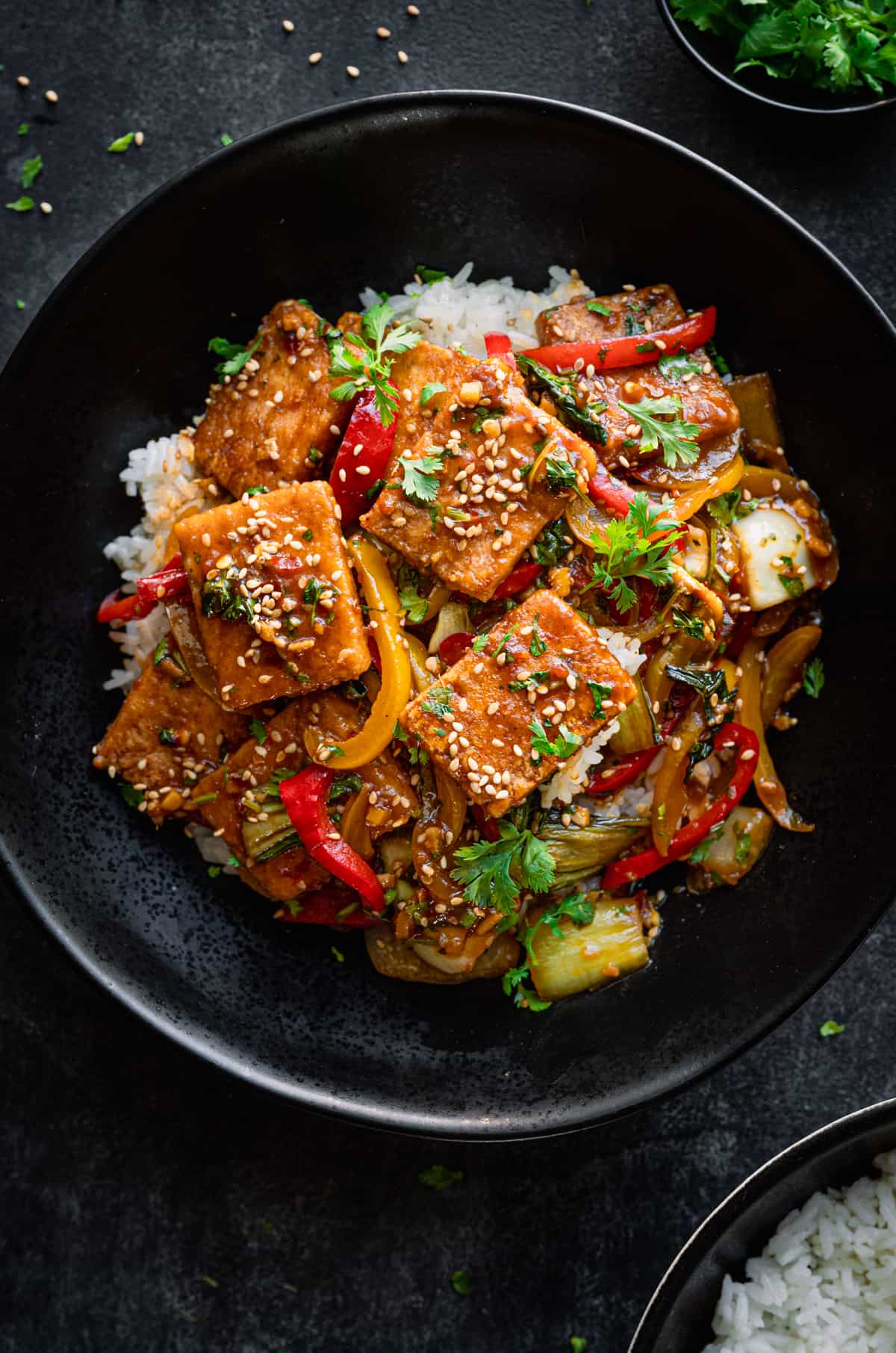
What is tofu?
Tofu is a soy product made from soybeans and water (AKA soy milk). The two are cooked together with a coagulant (usually nigari or gypsum) to help curdle the mixture. Those curds are then pressed into a solid block and left to cool.
Now, serving tofu raw isn’t always the best way to experience this plant-based protein because its flavor is very bland. But because of its texture, tofu is excellent at absorbing the flavors of other seasonings, sauces, and marinades.
Is tofu healthy?
Don’t listen to the fear-mongering about soy products! It’s been proven again and again that minimally processed soy-based foods like tofu are not bad for you.
In fact, tofu comes with heaps of health benefits. A 3-ounce serving of extra firm tofu has 70 calories, 8 grams of protein, 2 grams of fiber, 10% of daily calcium needs, 8% of daily iron needs, and 0g of saturated fat.
Also, a range of esteemed medical studies have repeatedly shown that moderate consumption of natural soy products like tofu (or tempeh, edamame, or soy milk) is associated with good heart health and linked with reduced risk for certain cancers, particularly breast and prostate cancer.
PS: “Moderate” consumption is considered up to twice a day, which is even more than I, a tofu-loving vegan, eat most days.
New to vegan cooking? Check out The Ultimate Vegan Grocery Shopping List to answer all your grocery shopping-related questions, then hop on over to The 5 Best Vegan Protein Sources to learn how to incorporate plant protein into your diet.

Different types of tofu
Not all tofu is made equally! Some are watery and soft while others are more coarse and porous, making them easier to shape into blocks. There are two main varieties of tofu: silken tofu and regular tofu or block tofu.
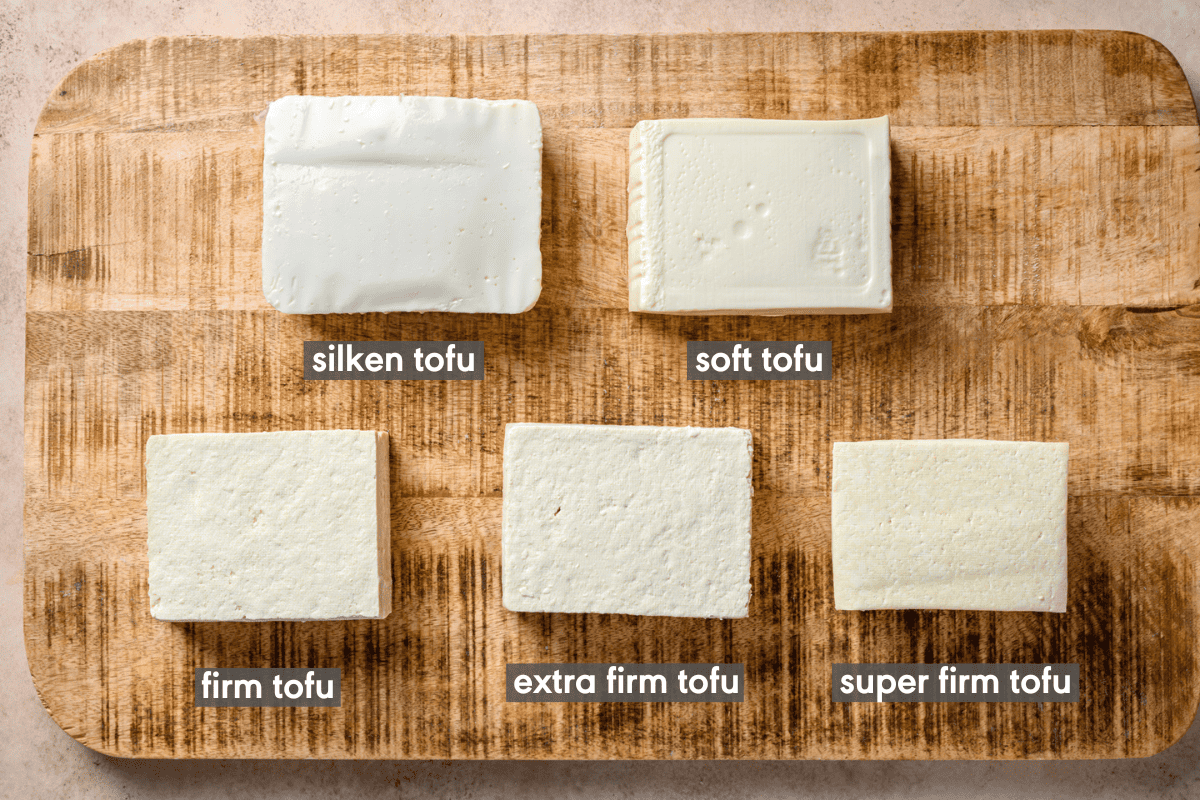
Silken tofu
Silken tofu is a “fresh” (uncooked) and very soft Japanese-style tofu. As the name suggests, it’s silky to the touch and very delicate. It contains so much liquid that if you were to pick it up, it would fall apart.
Variations
There are two variations of silken tofu: Refrigerated vs. aseptic (shelf-stable). I typically prefer refrigerated silken tofu taste-wise, but either variety works fine in recipes that call for silken tofu. You can find the refrigerated silken tofu alongside other blocks of tofu (e.g., firm tofu) at most grocery stores.
There are a few varieties of aseptic silken tofu (e.g., silken soft, silken firm). Aseptic silken tofu has a longer shelf-life, which means you’ll usually find them in the pantry aisle with other Asian products in most major grocery stores. The most common brand you’ll see is Mori-nu/Morinaga.
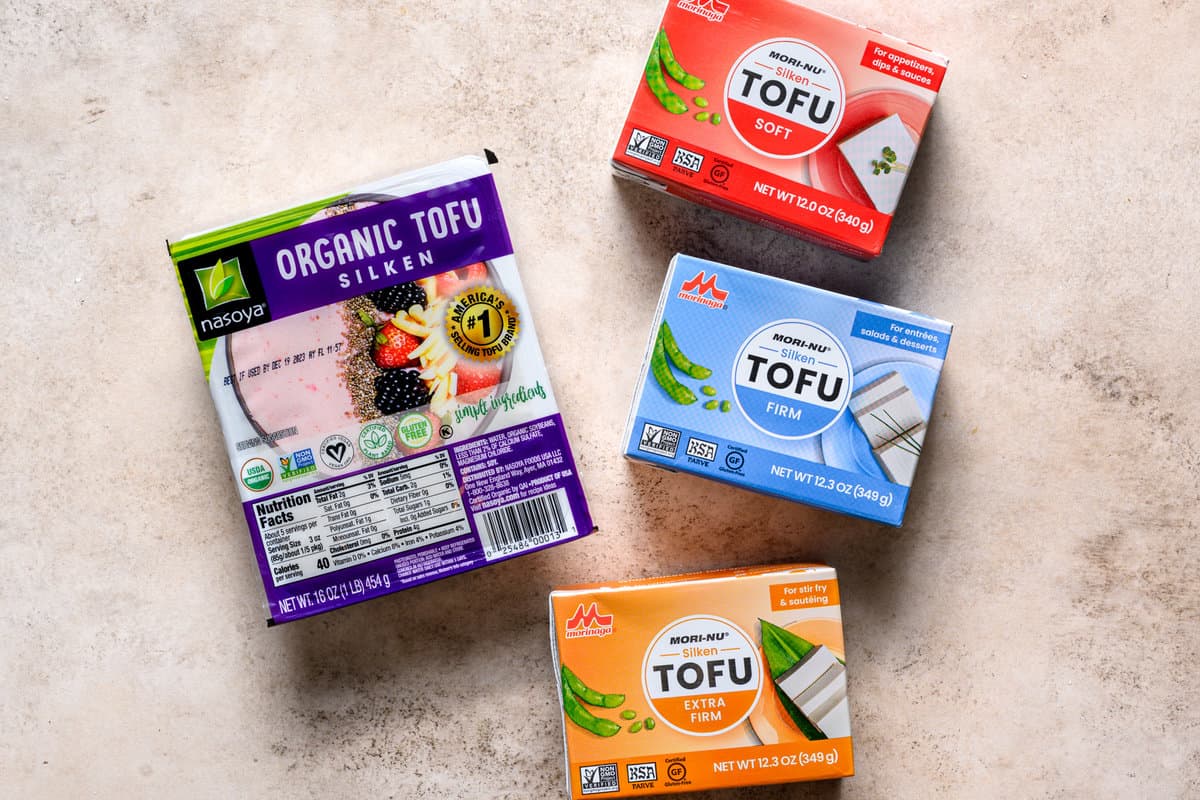
How to cook it
Cooking silken tofu is a little difficult because it crumbles so easily. Instead, its soft and watery nature makes it a fantastic choice for serving raw or blending and pureeing.
It doesn’t add any flavor when it’s used in vegan chocolate mousse, creamy dips, salad dressings, or French Toast batters. Instead, it lends a creamy, melt-in-your-mouth consistency without having to use heavy cream alternatives.
Want to bulk up your breakfast and add more protein without messing with the flavor? Blend silken tofu into your favorite smoothie recipe!
If you’re looking for a savory way to serve silken tofu, try serving an entire block of cold silken tofu with a deeply savory sauce and chili crisp (this recipe from the The Food Takes Flight looks amazing!).
In Chinese and Korean cuisine, silken tofu is often fried, then braised with stir fry vegetables in a Shaoxing wine-based sauce, like in this recipe by The Woks of Life. This vegan hot plate recipe from Woon Heng is similar but is cooked in a richer sauce made with liquid vegan eggs.
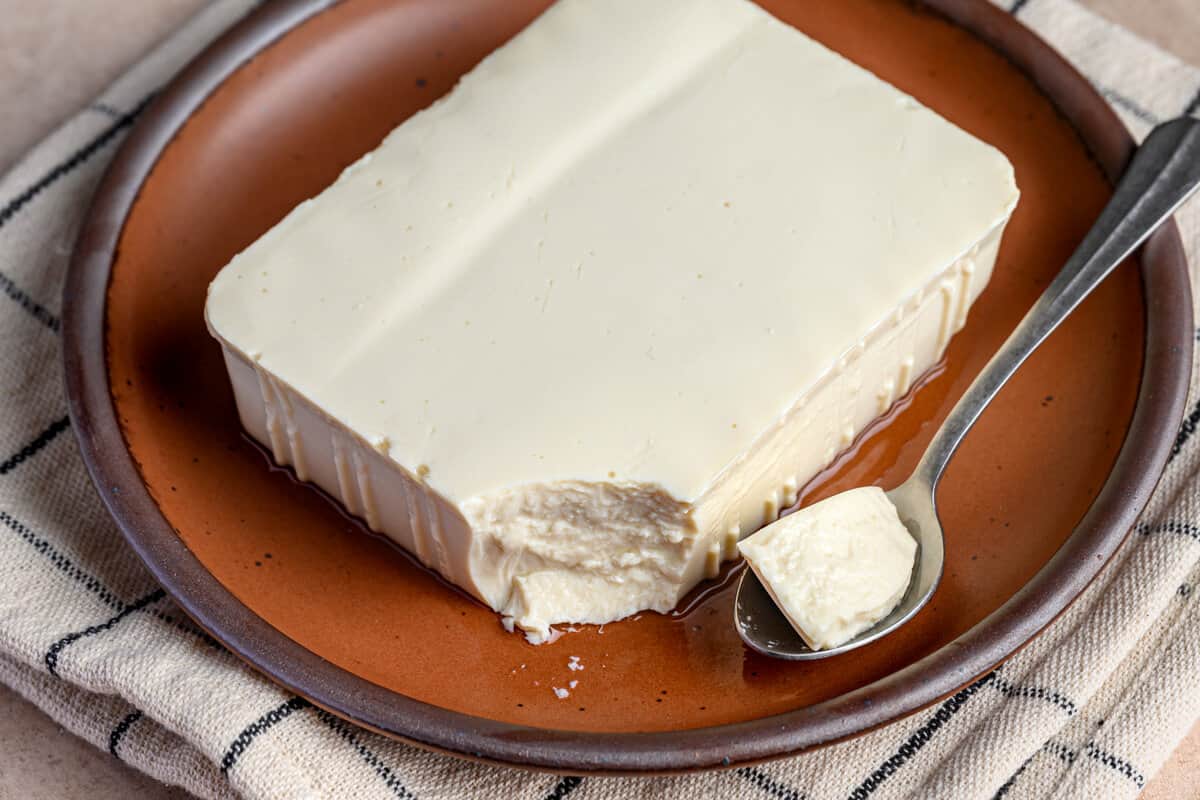
Tips for success
- Always handle silken tofu with care. It’s the most delicate type of tofu and will crumble very easily!
- Do not press silken tofu. Instead, simply drain the excess water from the packaging.
- Use it as a vegan egg substitute in recipes that rely on eggs for moisture (but not as a leavening agent) The tofu will provide moisture and binding to the baked goods. Use ¼ cup silken tofu for every 1 egg and add ⅛ to ¼ teaspoon of baking soda to help the baked goods rise.
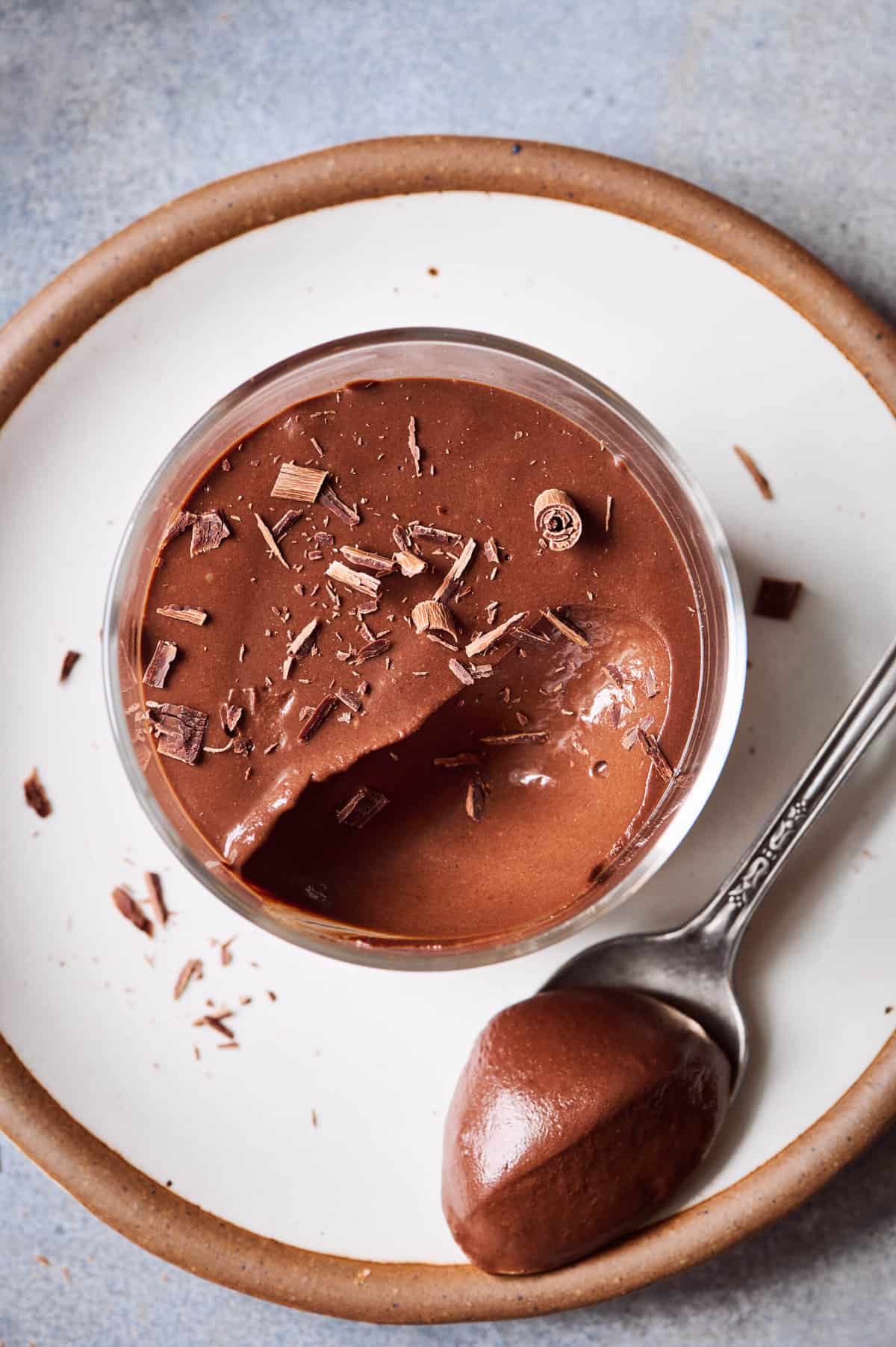
Soft tofu
This is the first of the “regular” block-style tofu varieties. It’s almost as soft and delicate as silken tofu but is firm enough to hold its shape when being handled.
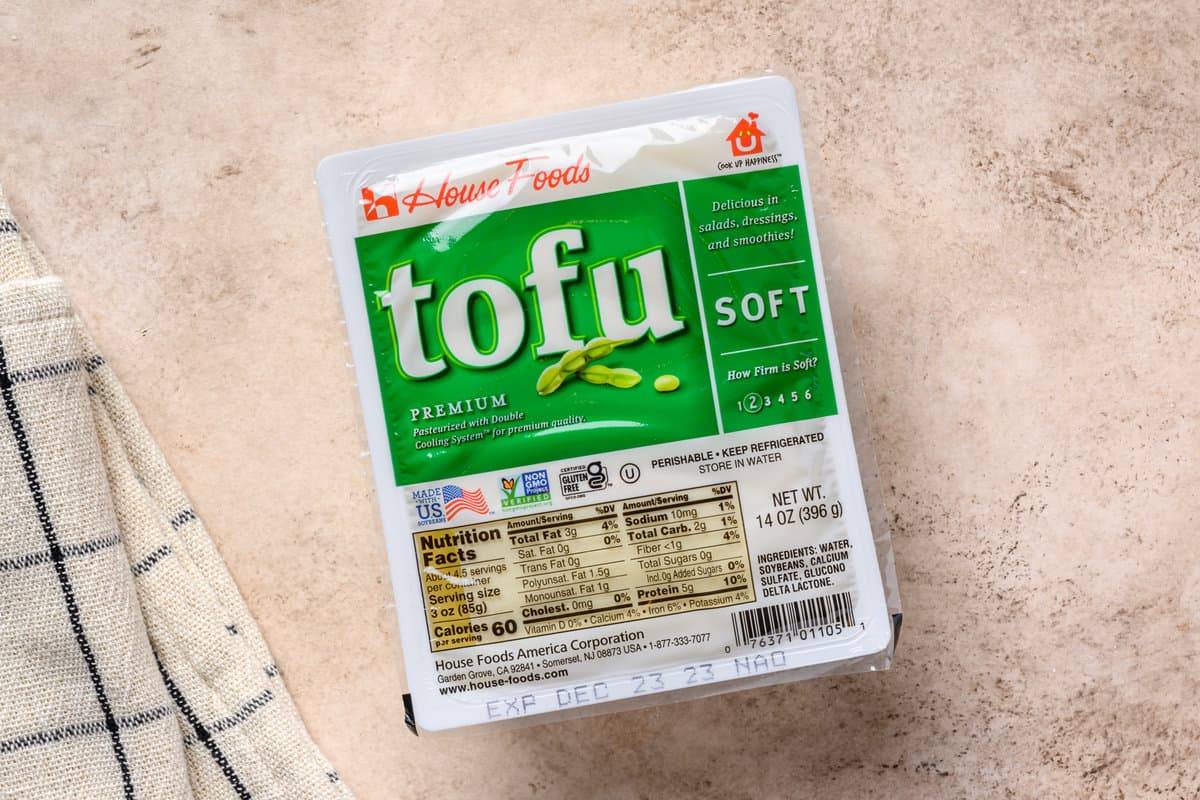
How to cook it
Soft tofu can often be used interchangeably with silken tofu. So if you can’t find silken tofu, you can blend soft tofu to make vegan mousse, pudding, salad dressings, homemade mayo, and creamy dips.
An easy way to enjoy soft tofu is raw in a cold tofu salad. Instead of layering soft tofu cubes over leafy greens, they’re placed in a bowl with a soy-based sauce and topped with aromatics, like green onion, sesame seeds, and Thai peppers.
If you like your scrambled eggs on the soft side, try swapping the firm tofu in my Tofu Scramble for soft tofu.
Firm tofu
Perhaps the most popular and widely available type of tofu, firm tofu is quite compact and is easy to crumble or slice, then cook. It’s not quite as meaty as extra and super firm tofu but still works well for pressing, marinating, and frying. And because it’s slightly softer than other firm varieties, it soaks up flavors really well.
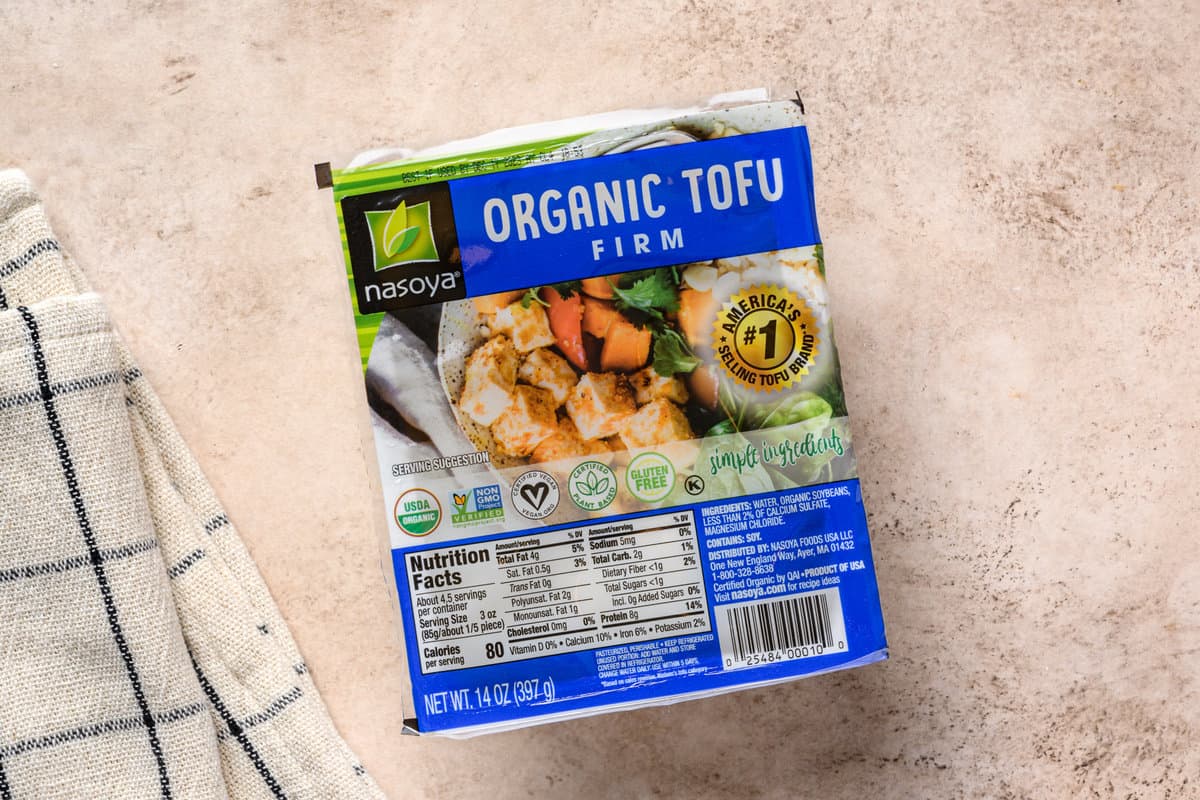
How to cook it
Turn to firm tofu whenever you want to pan fry, deep fry, braise, or even bread tofu! It’s versatile and comes with endless uses.
Firm tofu will benefit from being pressed ahead of time. Pressing is the process of placing heavy objects on top of the tofu to allow the excess water to drain. In the end, the tofu pieces become firmer, denser, and less watery, which enables the tofu to crisp up better and to absorb more flavor.
Learn how to press tofu below!
Firm tofu is a great variety to start with when you’re new to cooking with tofu. One of the easiest ways to prepare it is to slice it into small slabs and toss it in this flavorful Tofu Stir Fry or braise it in a delicious sauce, like in my Braised Tofu recipe.
Want to start your day with a boost of protein? Firm tofu is the best type of tofu for Tofu Scramble. It’s crumbled and pan-fried, which turns the outside lightly golden while the inside remains soft and pillowy (just like real scrambled eggs).
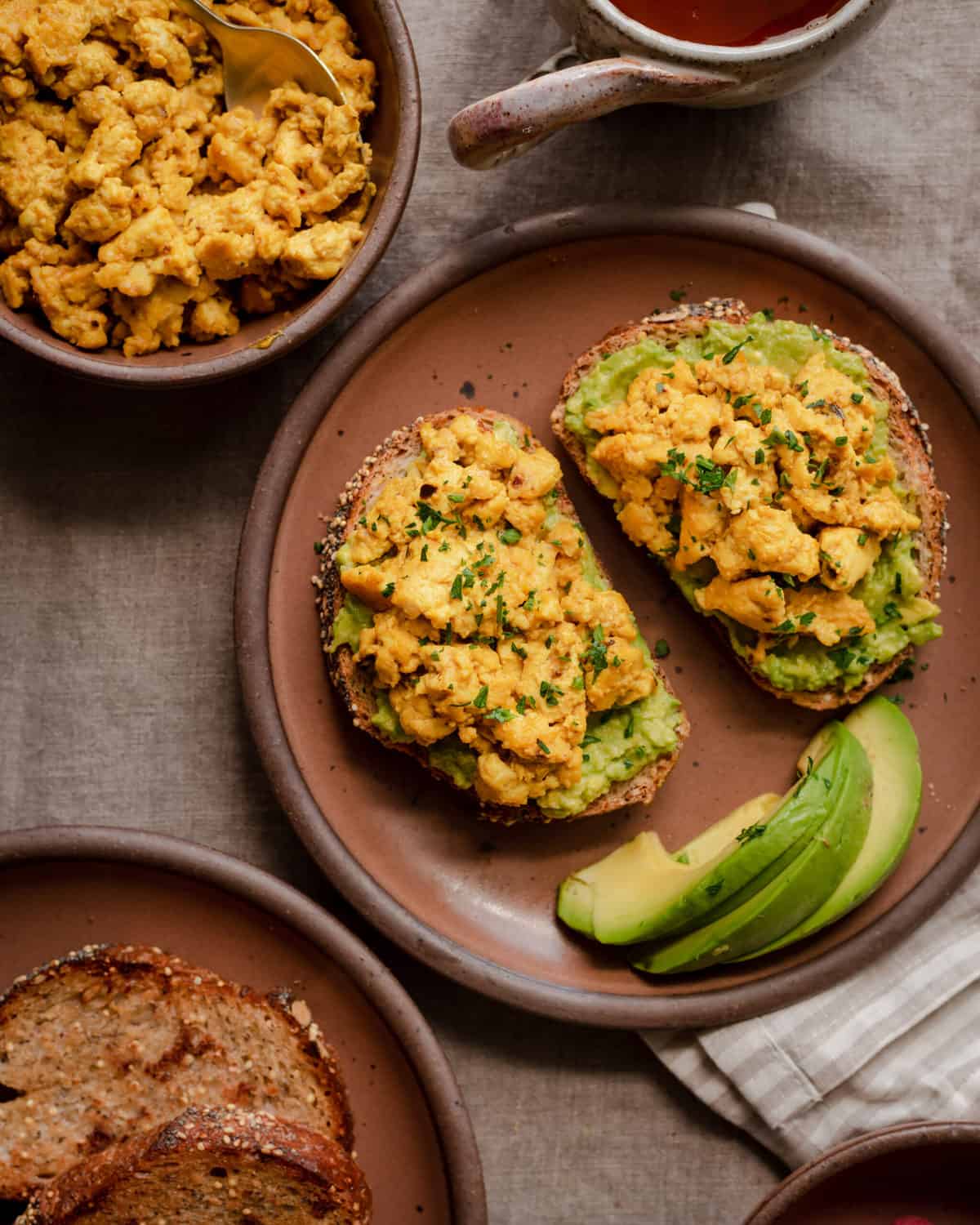
Extra firm tofu
Extra firm tofu is another variety of firm tofu that contains even less water. This makes it an all-around versatile vegan meat alternative that will soak up any flavors you throw at it. I typically use extra firm tofu in many of my recipes because it doesn’t need to be pressed for very long and is less delicate to handle.
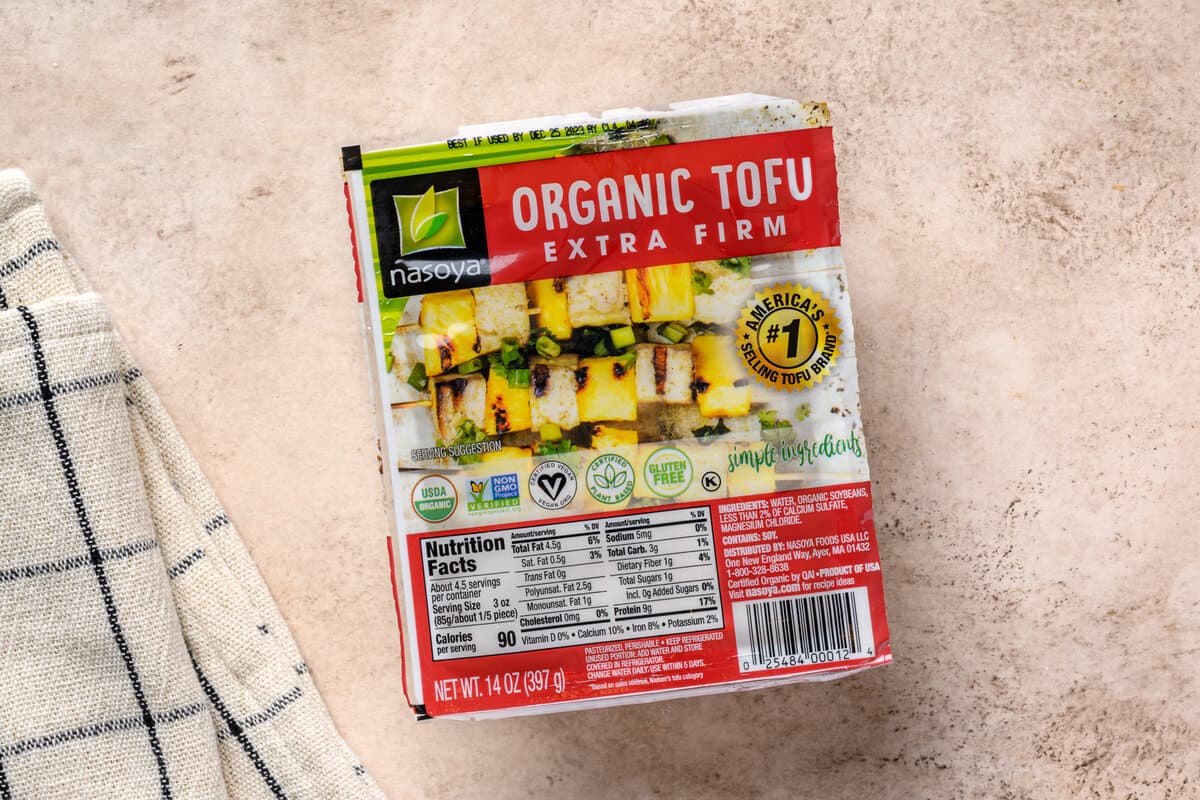
How to cook it
You can cook extra firm tofu any way you cook firm tofu. It’s extremely versatile and one of the best options for home cooks because it’s so easy to work with!
Its texture is firm enough to be cooked over high heat, such as pan-frying, air frying, baking, braising, and grilling. The outside becomes golden and crispy while the inside remains soft and tender.
Grilled tofu is a delicious way to add plant-based protein to your summer meals. Either grill the slabs or tofu “steaks” as-is or thread tofu cubes onto skewers. Take it over the top by marinating the tofu in a zesty lime marinade ahead of time for a burst of flavor.
Speaking of marinating tofu, soaking extra firm tofu in vibrant, flavorful sauces is a great way to infuse flavor into this otherwise mild plant-based protein with big, bold flavors. In my Tofu Tikka Masala, extra firm tofu cubes are marinated in an aromatic yogurt sauce before they’re broiled and tossed in a marsala.
My Vegan Feta uses a Greek-style marinade to impart zesty, herbaceous flavors into small extra firm tofu cubes, replicating realistic feta flavors.
Pro tip: Marinating tofu isn’t always easy. After testing marinated tofu recipes for years, I’ve come up with a few helpful secrets so you too can learn how to marinate tofu like a pro. Check them out below!
Lastly, extra firm tofu is my tofu of choice for tofu ricotta, though you can also use firm tofu. It’s a creamy vegan cheese that’s wonderful in Vegan Lasagna and Pumpkin Stuffed Shells.

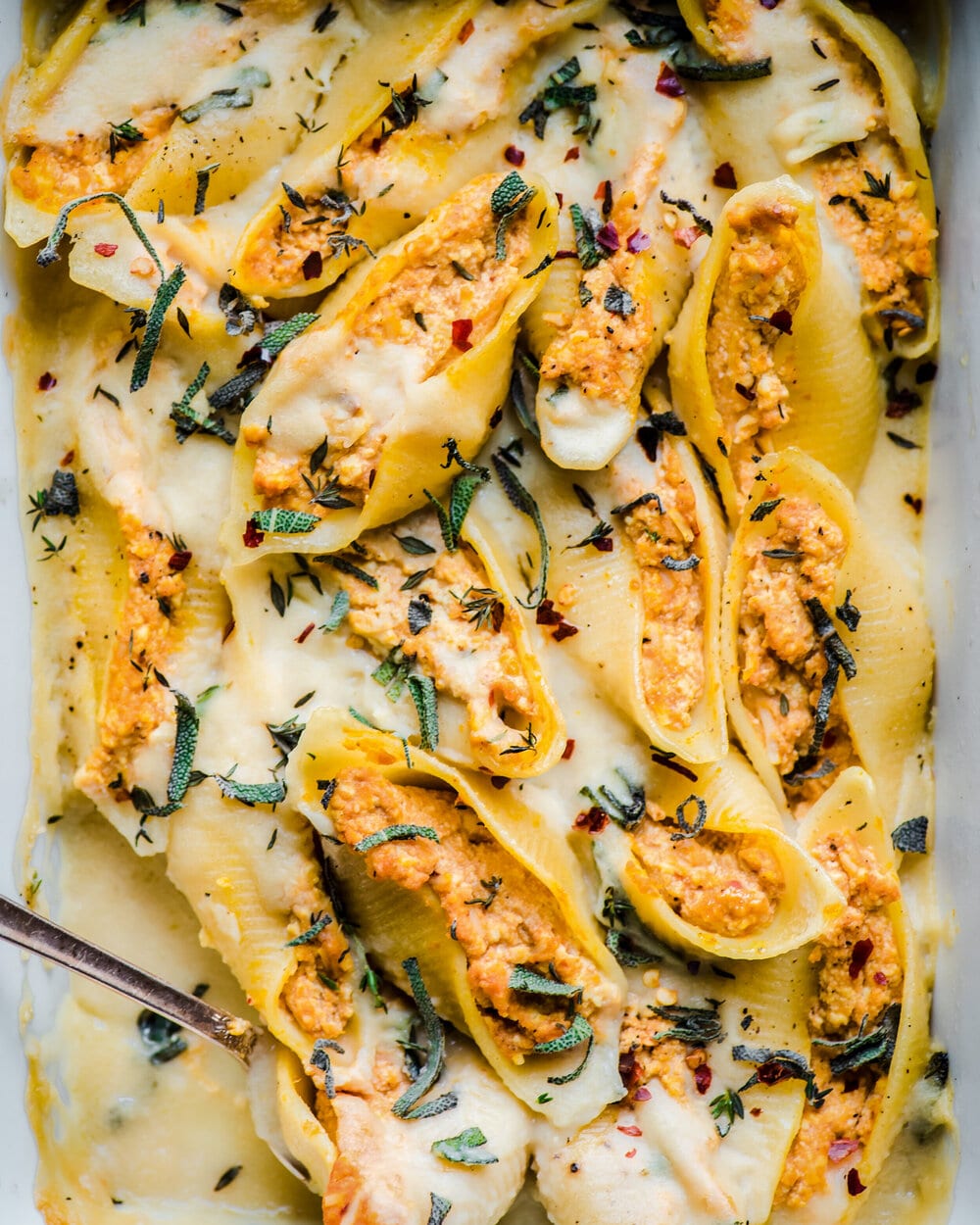
Super firm tofu
Much like extra firm tofu, super firm tofu is very dense and meaty. It also contains almost no water! This means it doesn’t need to be pressed ahead of time and is very high in protein.
There are many benefits to cooking with super firm tofu, but only if your budget allows it. It’s typically the most expensive variety of tofu you can buy because all of the water has already been pressed out. Its dense texture is great at mimicking meat, but it also means that in certain applications, it doesn’t soak up flavor as well as softer varieties (this is especially true for marinated tofu).
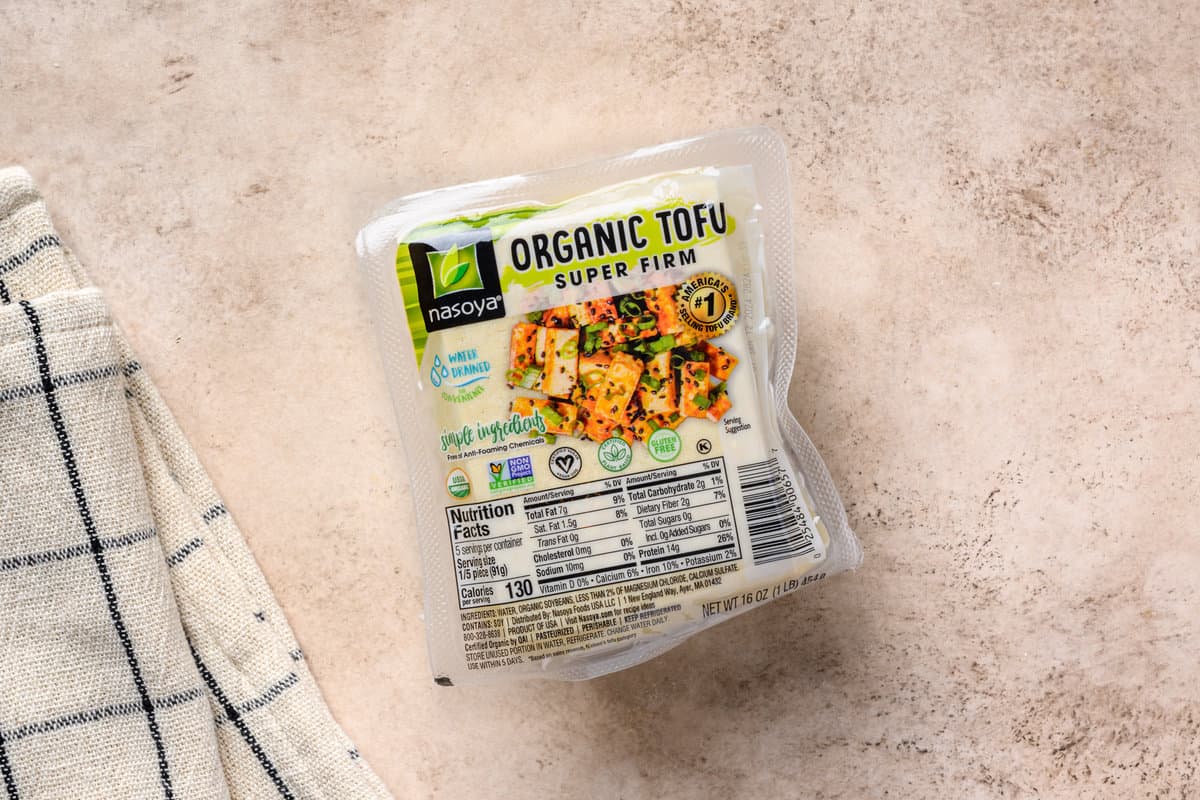
How to cook it
My favorite way to cook super firm tofu is to crumble the brick into small pieces and pan-fry. They become golden and crispy very easily, lending a nice meaty crunch to dishes like my Creamy Coconut Rice and Vegan Burrito Bowls made with homemade Sofritas.
It’s the best variety of tofu to use for vegan chicken substitute recipes, particularly nuggets! Rip the tofu into cubes, toss them in poultry seasonings and breading, and air fry or bake until crisp and crunchy.
Super firm tofu is also ideal for shredding because it doesn’t need to be drained ahead of time. Simply take a box grater and start grating the block of tofu like you would a block of mozzarella. Pan fry the shredded tofu in a bit of oil over medium-high heat until golden brown and crisp yet chewy.

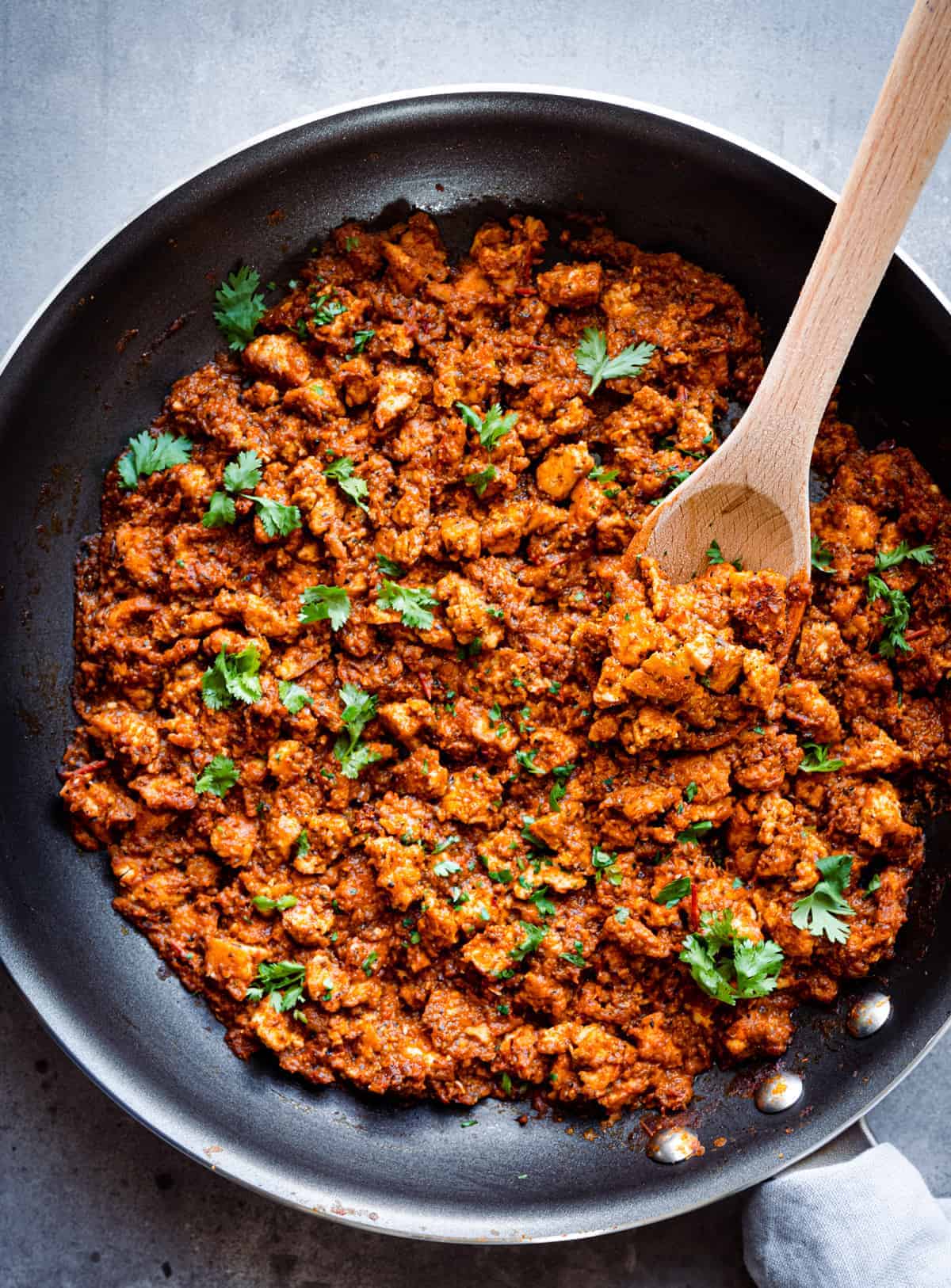
How to make tofu more flavorful
Enhancing the taste and texture of tofu is easy! There are a few handy tips and tricks you can use to really take it over the top, such as:
Method 1: Pressing tofu
Firm varieties of tofu (save for super firm tofu) are almost always packed in water. Even when you drain the tofu from the water, if you squeeze it, you’ll notice the tofu is full of water.
Pressing out the excess moisture has two benefits: (1) with less water, the tofu is better able to absorb other flavors (from sauces, marinades, etc.); (2) with less water, the tofu is better able to crisp up.
As you can see from the photo below, pressing tofu significantly reduces the water quantity, leaving you with firmer, denser tofu.
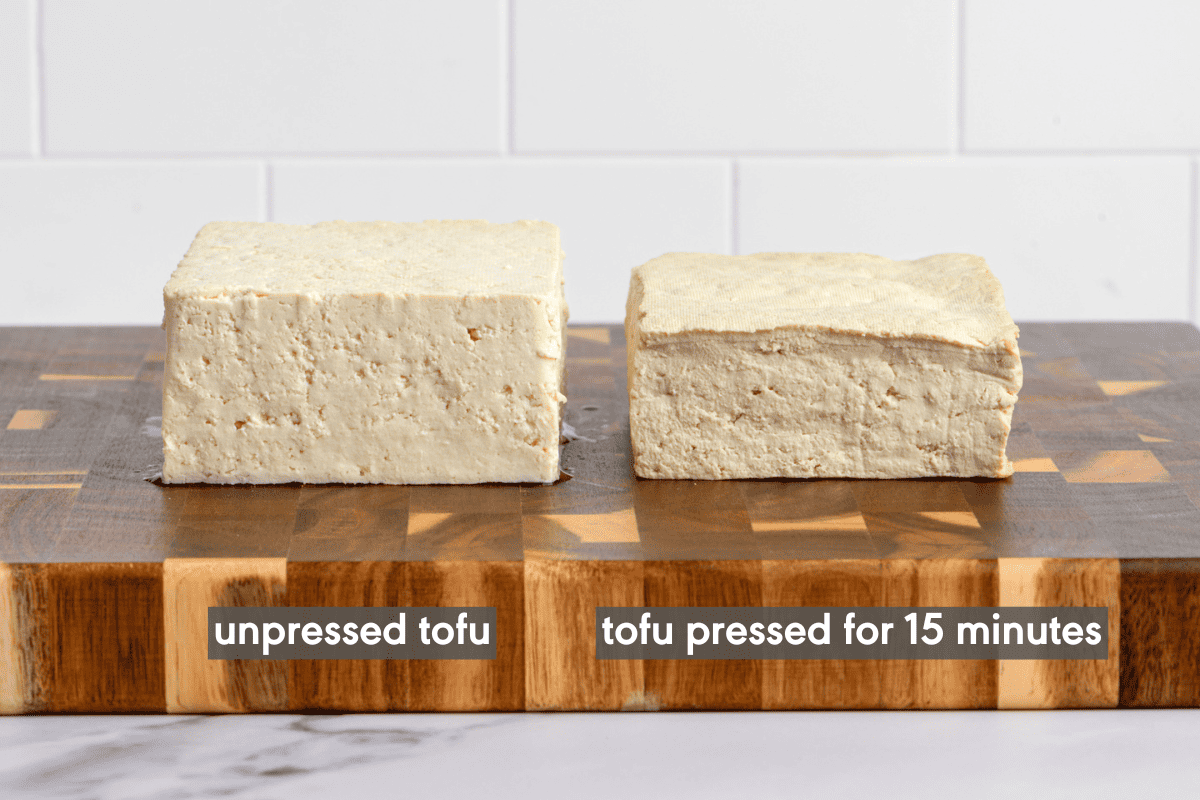
Learn how to press tofu using either of the two easy methods below:
How to press tofu (the classic method)
- Drain the water from the package, then wrap the brick in a clean kitchen towel or layers of paper towel.
- Place it on a cutting board or large plate. Weigh down the brick with a heavy cookbook, a cast iron skillet, or a large plate weighed down by a few cans of beans or tomatoes.
- Let the water drain from the tofu for at least 10 minutes or up to 30 minutes depending on the recipe. Change the towel halfway through if needed.
Time-saving tip: Slice the tofu brick into 4 vertical slabs, then press the tofu. Just be careful to not squish the tofu. This is more efficient than pressing the whole block at once.

Use a tofu press
A tofu press is a device designed to press all of the water out of a brick of tofu. We got this one recently and love it (affiliate link). Each press will have different instructions, so make sure you follow them carefully.
Method 2: Freezing tofu
You’ll be amazed at how freezing, then thawing a block of tofu can improve its texture and flavor. This is because freezing tofu essentially changes its molecular structure!
Once it’s frozen, the water inside the tofu turns into ice crystals. These ice crystals melt upon thawing, which leaves little air pockets behind that are better at absorbing flavors, just like a sponge.
Frozen, then defrosted tofu is extra exciting because it’s spongier, meatier, and chewier. It zhuzhes up any dish where the tofu needs to be fried and/or simmered in flavorful sauces or spices because it soaks in flavor like a dream. Our favorite ways to use it is in this Vegan Curry with Tofu, Tofu Stir Fry, and Marinated Tofu.
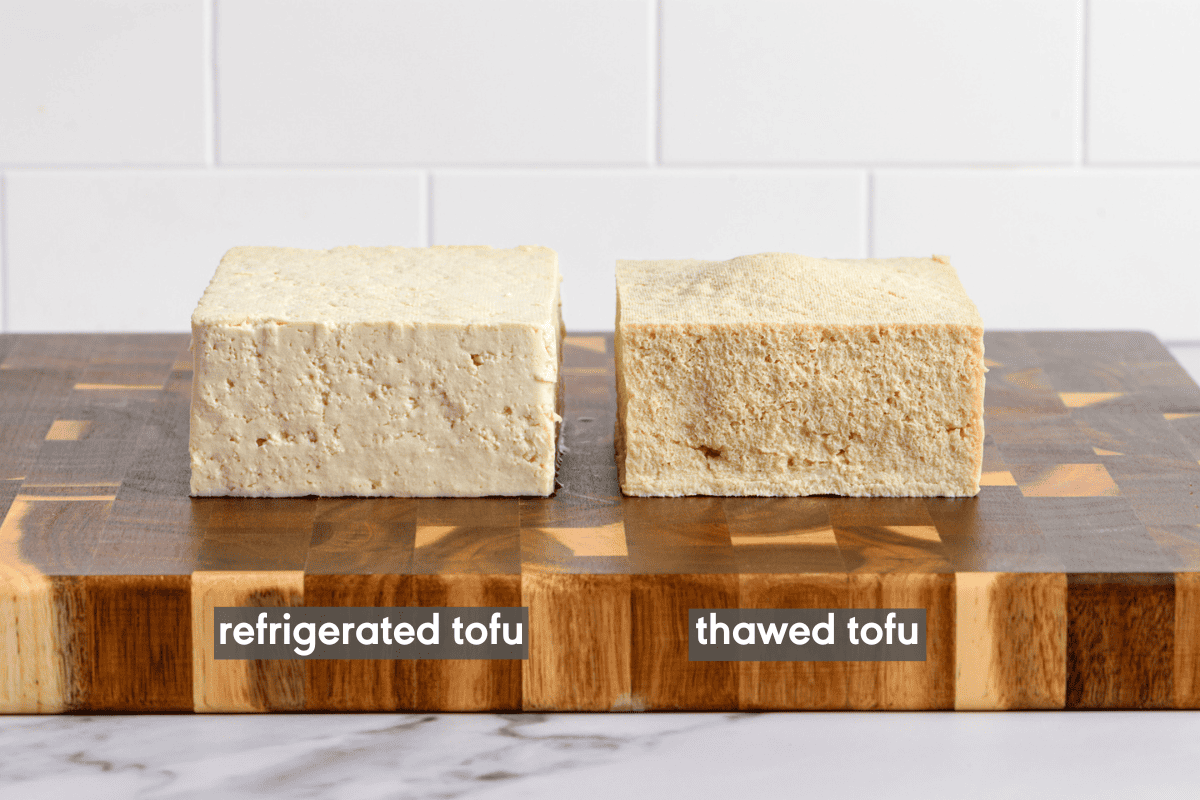
How to freeze tofu
There are two methods:
- Chuck the entire unopened package into the freezer and let it freeze for a minimum of 10 hours. Be sure to not place anything else on top of the tofu package, as it will interfere with the freezing process.
- Drain the tofu and transfer it to a freezer-safe container (with or without the water from the package). Freeze for at least 8 hours.
In our experiments, this second method yielded slightly better and more consistent results but both methods work great.
How to defrost tofu
Defrosting frozen tofu isn’t rocket science but can be done in three different ways depending on how much spare time you have:
- Option 1: If you’re not in a rush, leave the tofu to thaw in the fridge. This can take between 1 and 2 days, depending on how long you froze the tofu.
- Option 2: Defrost the tofu at room temperature for up to 2 hours, then return it to the fridge. Don’t leave it out for more than 2 hours or else unwelcome bacteria could form.
- Pro tip: Defrost your tofu on an aluminum sheet pan like this (affiliate link). Some thermodynamics magic happens when you defrost frozen food on aluminum defrosting trays. It gets the job done so much faster! Alternatively, leave the tofu in a bowl or pan of warm water to speed things up.
- Option 3: When you’re very short on time, defrost the tofu in the microwave. First, place it under warm running water so you can slide the tofu out of its packaging. Next, place it in a shallow bowl and microwave on high in 1- or 2-minute intervals until thawed, squeezing in between rounds to see if it’s still frozen in the middle (this can take 8 to 12 minutes).
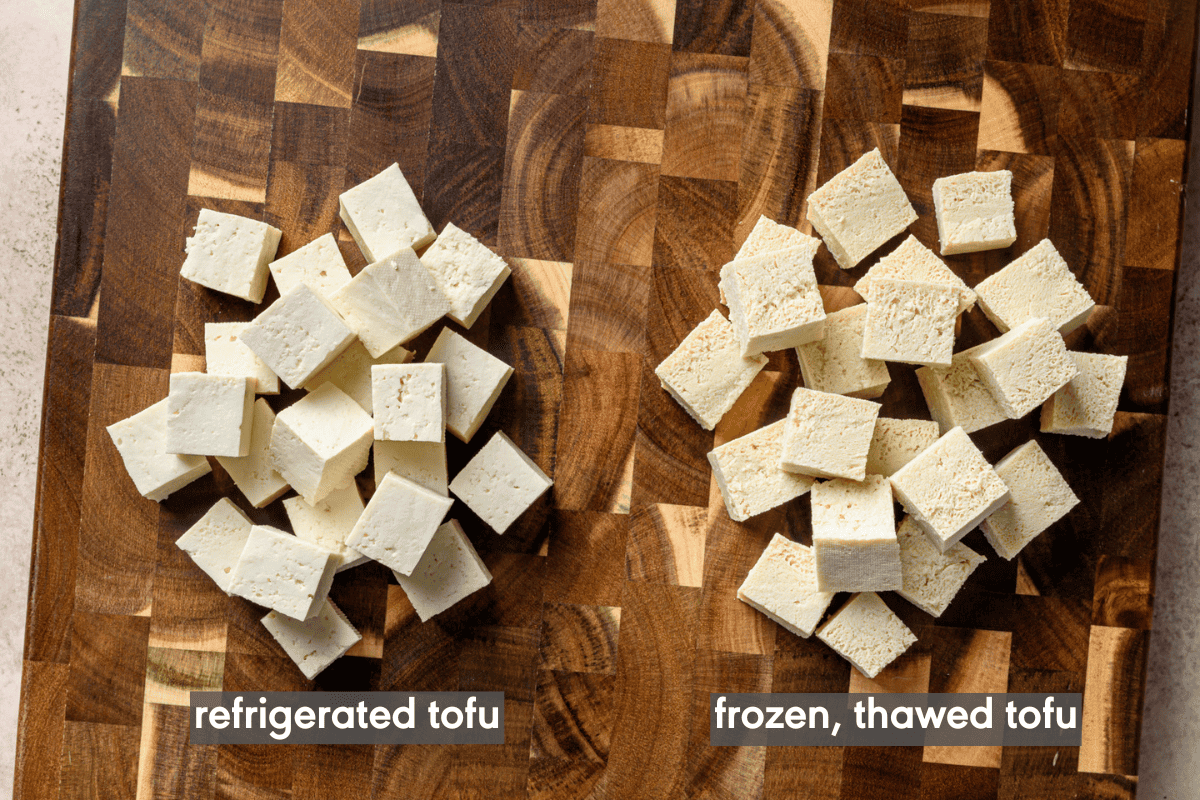
Method 3: Boiling tofu in salted water
Boiling tofu in a pot of generously salted water does three things:
- It drives out even more water from the tofu (you’d think it would do the opposite, but hey, science!). Maybe not as much as pressing, but the results are still better than leaving the tofu unpressed.
- The generous amount of salt seeps into the tofu, making it more flavorful.
- It makes the tofu chewier, spongier, and slightly meatier.
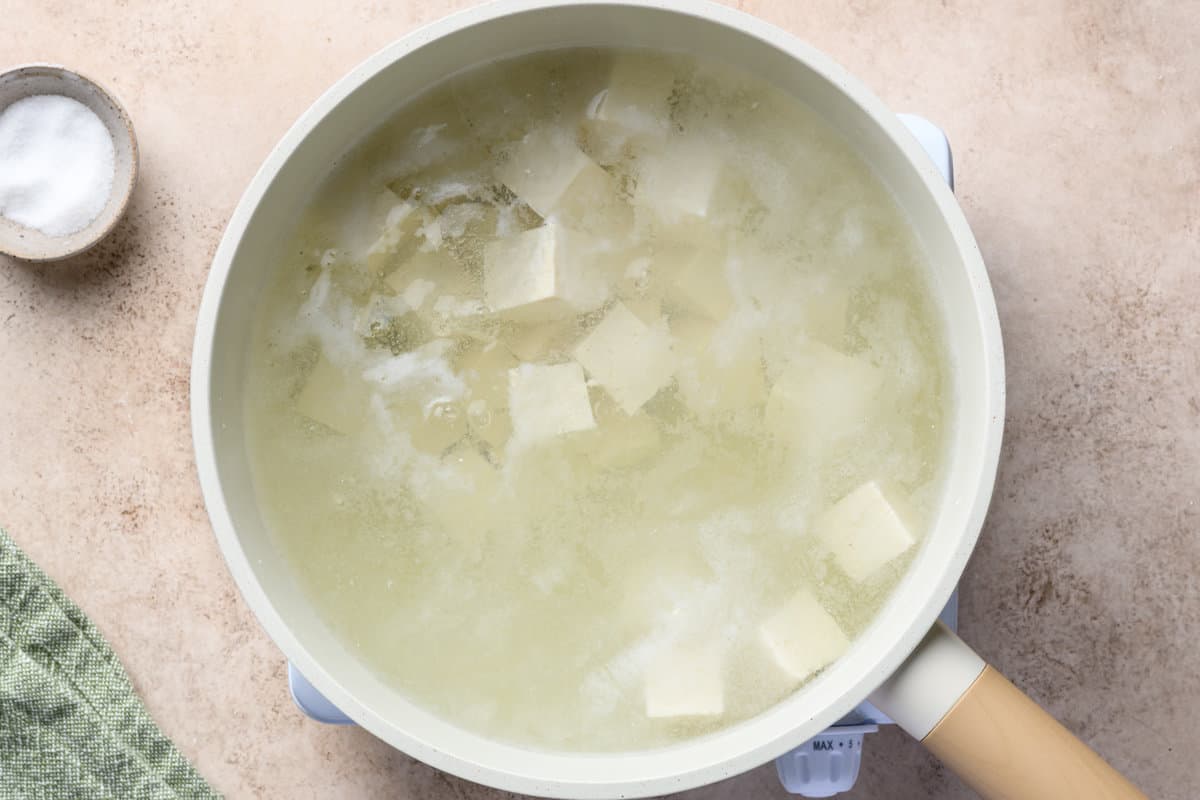
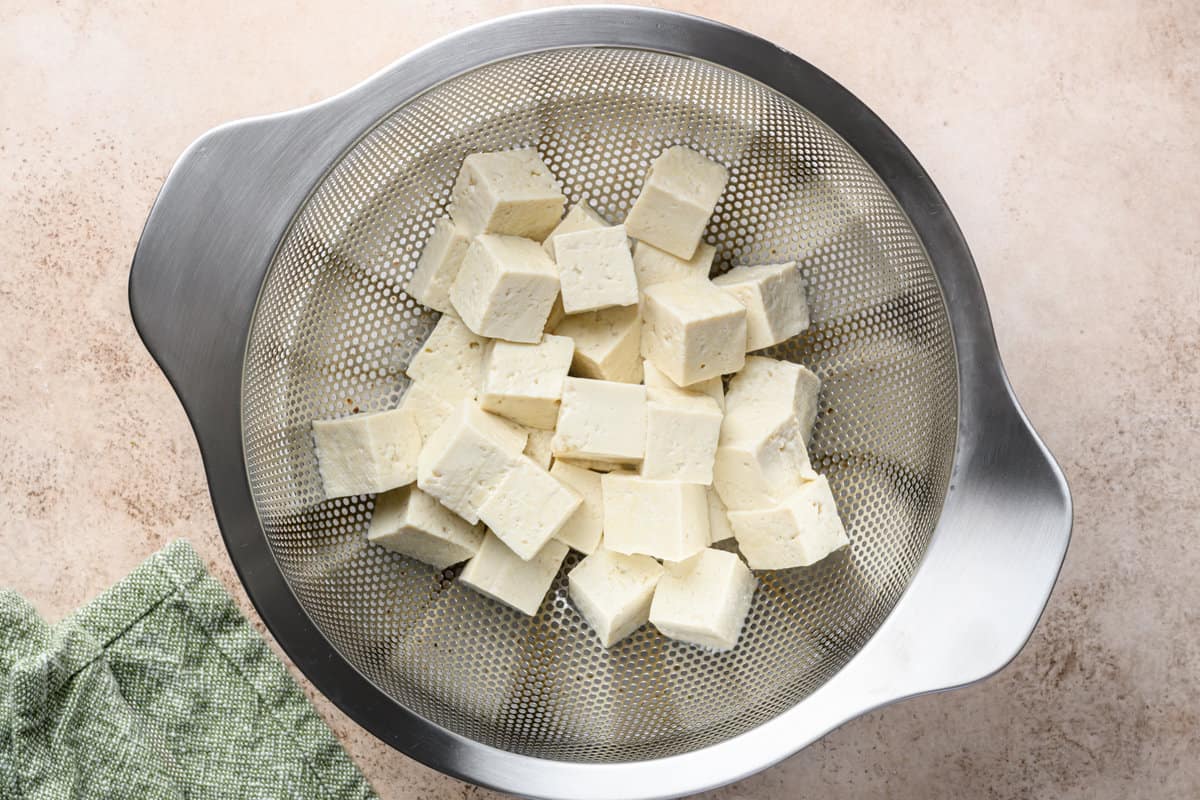
Best of all, this process only takes a few minutes. All you need to do is boil cubes of tofu, drain, and dab them dry. Voila! It’s ready to be stirred into Vegan Palak Paneer or Tofu Curry.
Method 4: Marinating tofu (be careful with this one!)
Marinating tofu may sound like an obvious way to add delicious flavors to raw, bland tofu, but it isn’t that simple. Regular refrigerated tofu isn’t very porous, which means the marinade will not seep into the interior as well as, say, chicken or other meats. Also, tofu is very watery, so marinating it in liquid does not help its texture.
I worked hard to come up with the perfect method for marinating tofu, which you can learn about in my Seriously Delicious Marinated Tofu recipe. The tofu is frozen and defrosted first to make it more spongy and porous than its natural state. The result? Mind-blowing, sponge-like tofu that easily absorbs the deliciously savory East Asian marinade.
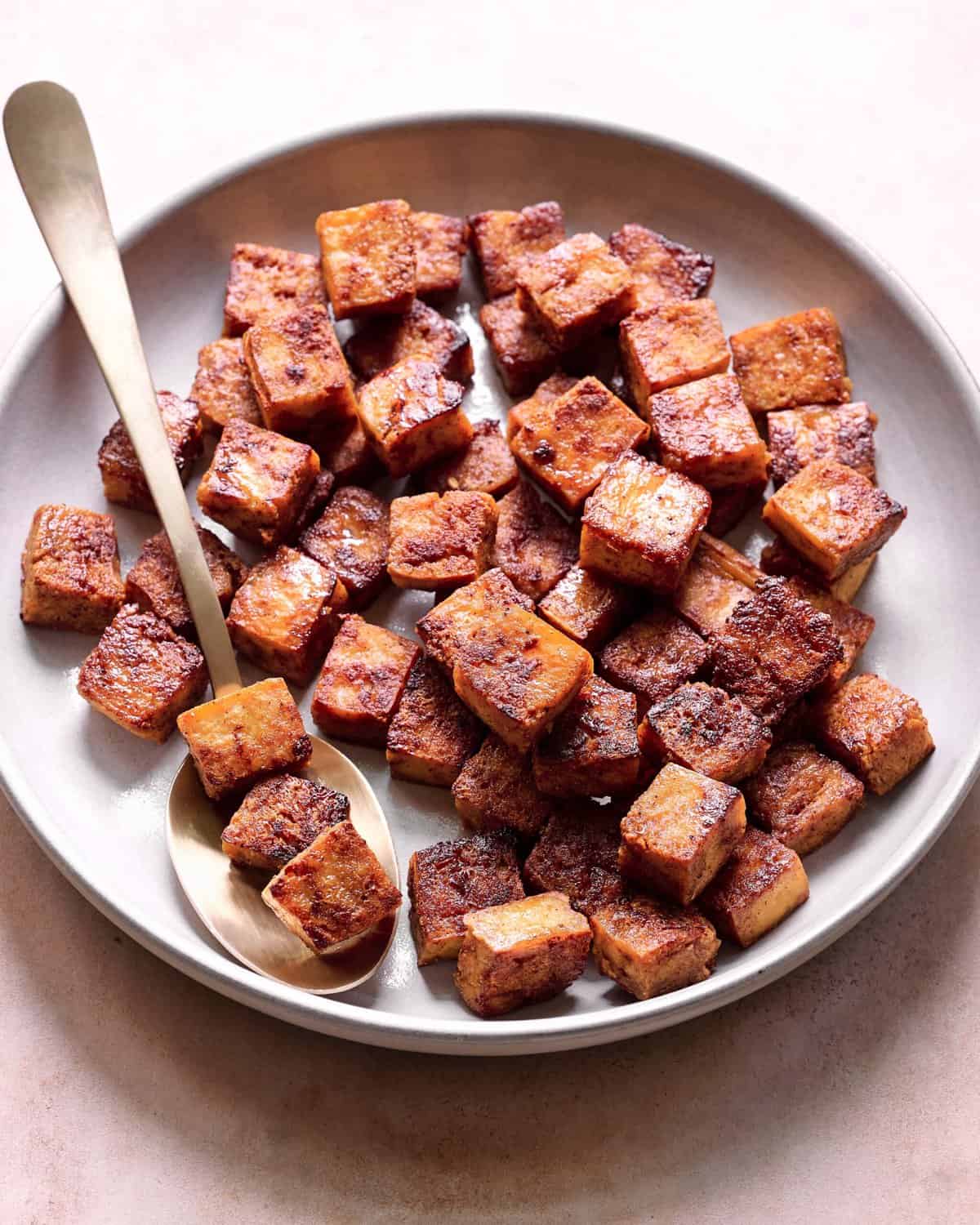
How to cook tofu
As we’ve learned, the endless varieties of tofu can be infinitely flavored and prepared. The same goes for the way you cook it!
Whether you want to bake it in the oven, fry it on the stove, or char it on the grill, it’s easy to transform the firm varieties of tofu into a crispy, golden plant-based protein to add to all of your meals.
Method 1: Baked tofu
Baking tofu is a wonderful hands-off method, and my recipe for simple baked tofu produces slightly crispy on the outside and pillowy on the inside tofu every time. It’s always a good idea to toss the cubed or sliced tofu in a layer of seasonings, oil, and starch (cornstarch, arrowroot, potato starch, or tapioca starch) before baking. This way, the outside has an easier time crisping while the tofu becomes more flavorful.
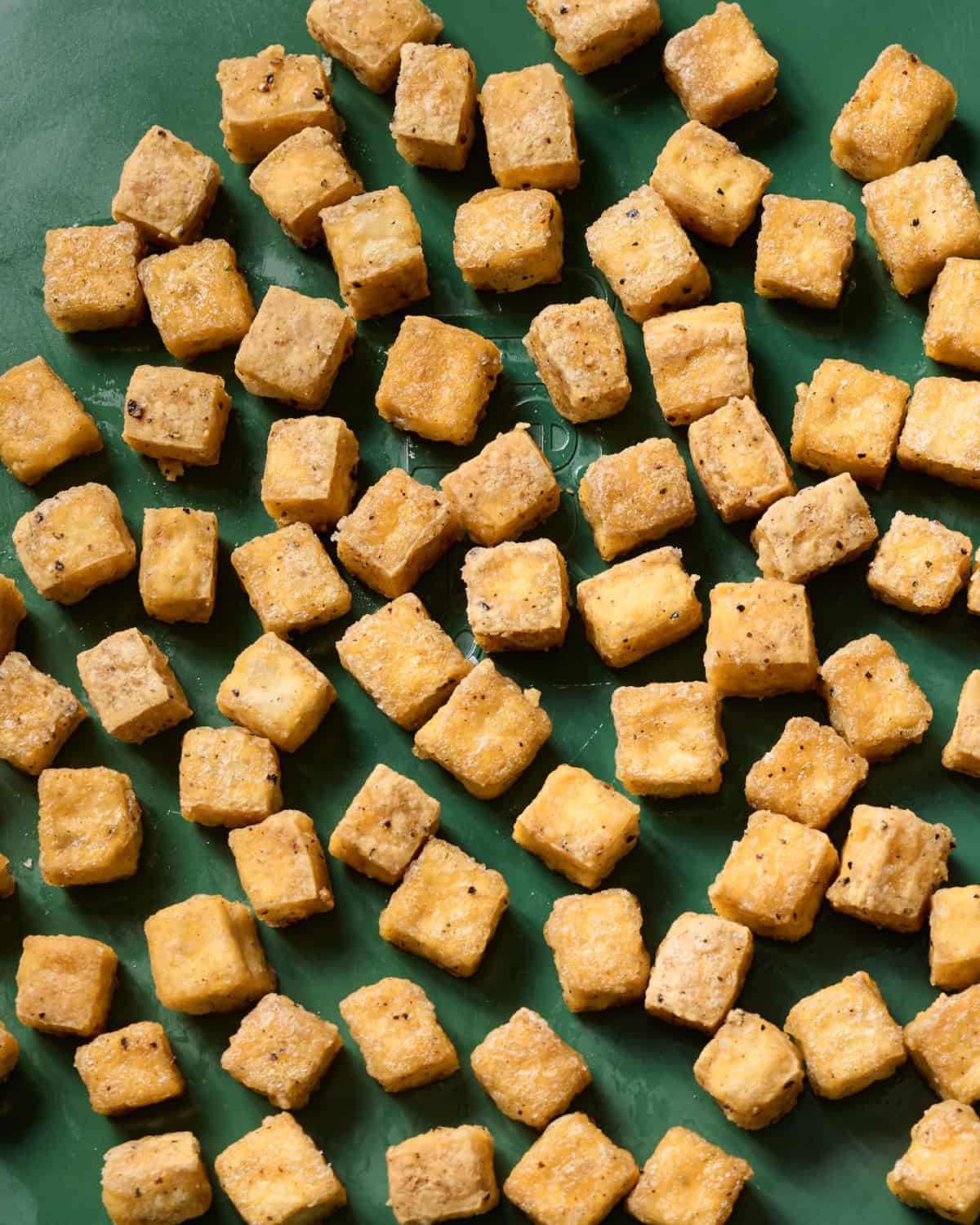
Method 2: Pan-fried tofu
You can easily make golden crispy tofu squares or cubes with the pan-fried method. The pieces can be fried with a light seasoning of salt, like in my Braised Tofu recipe, or coated in cornstarch and seasonings for an extra crispy coating, like in this Tofu Stir Fry.
My simple recipe for pan-fried tofu yields extremely delicious and crunchy tofu that tastes like it’s been deep-fried and can be customized with different seasonings and spices.
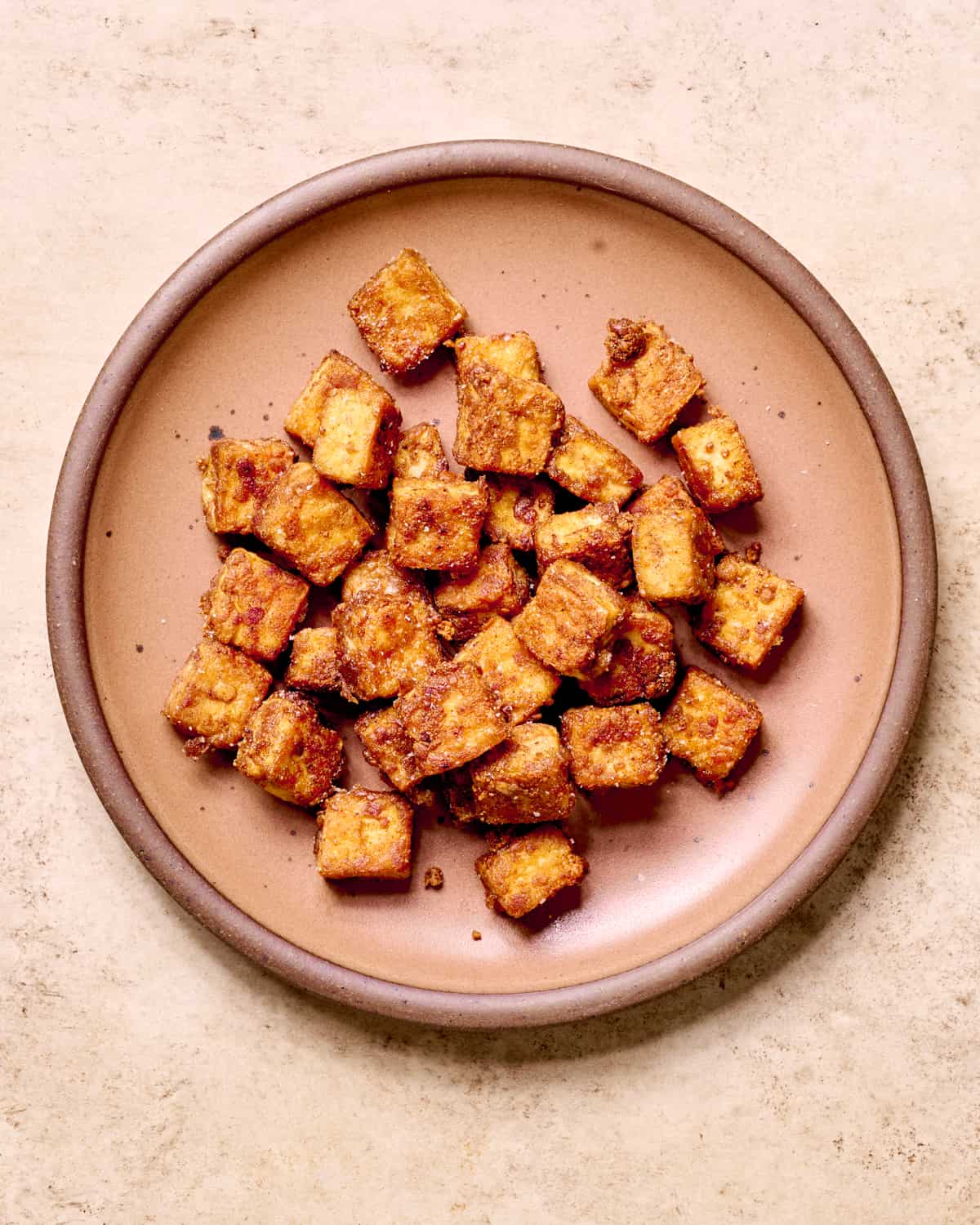
Method 3: Grilled tofu
Summer = grilling season and what better to serve for dinner than crispy, lightly charred Grilled Tofu Skewers? The grill works its magic with tofu, adding deep, smoky flavors to every bite. It’s always best to press and marinate tofu before grilling to enhance the flavor and meaty texture even further.
- Preheat the grill over medium-high heat until the grates are sizzling hot (about 10 minutes).
- Season the grill with a high-heat oil, like avocado oil. Repeat this a few times to build up a good layer of seasoning.
- Add the tofu slabs or tofu skewers to the hot grill and reduce the heat to low.
- Close the grill and grill for about 20 minutes, rotating the skewers or flipping the tofu slabs every 3 ½ to 4 minutes.
- Brush on some reserved marinade while the tofu continues to char, then serve.

Are you excited to start cooking with tofu more now that you know all of these expert tips and tricks? Let me know what your favorite tofu tip is in the comments!




Hi Nisha, i’m new to a plant-based diet and want to love tofu, but so far I’m not succeeding with it. I’m really trying to reduce or eliminate oil, so frying is tough. Do you have recommendations for using an air fryer?
From Nisha: “Hi there, I’m not oil-free so I’m not sure I have a ton of advice. I have tried air frying tofu and it works well (you can check out this video), but I did use oil because I found the tofu to be dry without it. You can try this technique and use a bit less oil and it should still be nice.”
Hi Nisha! Thanks for this comprehensive guide on how to make tofu taste even better! I’m curious in your experimentation if you’ve tried combining techniques? For example, can you boil tofu in salt water first and then freeze it? (Or vice versa?) Or I’ve also heard people twice-freezing tofu too and say that that’s the ultimate method. Would love to hear your thoughts!
From Nisha: “Good question! I have tried combination techniques in a few instances. For instance in my Tofu Curry recipe, I use defrosted tofu and I then boil it in salted water for 2 minutes. This really enhances the tofu’s ability to absorb the flavors of the curry and to get chewy.
As for freezing tofu twice, I have only tried that once or twice because it does require a lot of advanced planning. but it is supposed to be wonderful in recipes where you bread the tofu and deep fry it (to mimic the texture of chicken).
Personally, when I have deep fried tofu in the past, I really like using medium firm tofu that I soak in salted water for 10 minutes, or you can boil it in salted water on the stove for 2 minutes. Then coat it in some sort of batter and deep fry it. I’m sure it depends on the recipe but when I have tried deep frying previously frozen tofu, it felt like it absorbed too much oil.
Lots of variables to test, lots of deliciousness to explore! I’m glad you’re curious about it all!”
This is super helpful – thank you for replying Kaitlin!
You’re very welcome, Josephine! Happy cooking!!
This is such a great guide to those of us who are still learning to use tofu! I would really like to know a little about storing tofu. I’ve never seen a use-by date on the tofu in our grocery store; how long does it keep if refrigerated unopened? What is the best way to store unused portions: in the original liquid, or in water? How long will that keep? How long can we keep frozen tofu in the freezer before it gets unusable? So much to learn for beginners! Thanks Nisha.
Hi Mindy, usually the “best by” date is written in very small font, it might even be on the back of the package. If tofu is unopened, it should last at least a month. Once the tofu is opened, you can store it for up to 5 days in an airtight container (either with fresh water, or without water). After 5 days, it will start to get slimy and then smelly. If you want to store it for longer, we recommend freezing it. Freezing the tofu, as I mentioned in the post, can actually enhance the texture in many recipes, so this is a nice option. You can freeze tofu for 4 to 6 months. Hope that helps!
Fantastic knowledge for a learner, thank you
You’re very welcome, Kim!
This is such a helpful guide! I really appreciate you sharing this. Some key take aways are keeping my firm tofus in the freezer so that step is out of the way, and I think even just meal prepping tofu in advance because I always want to have it… just assuming I’ll want it in some of my meals in the week regardless of what we are having. Also I’ve saved your marinated tofu recipes… I really appreciate all your hard work nailing down the best way to have texture AND flavor! YOU’RE SUCH A GEM! Thanks so much. Xx
Hi Carmella, we so appreciate your feedback! :) Thank you for taking the time to read the post, and it’s great you’ve found value in it. Cheers!
I really loved all the great ideas but I’m a bit “old school”. So I’d would enjoy all these ideas in an old fashion book. Pause for laughter, is there any possibility of you might do this in the future? Thanks for all your hard work in the research department. J
Hi John, thanks for the tip! I’ll pass the request to the team :)
Nisha, thank you for taking the time and effort to explain the ins and out of tofu.
We all appreciate it so much and are more likely to use it now that we have some
education.
One question and possibly a suggestion for the next time you produce something like this. Is this tofu info available via PDF or such? If not, could it be? I could not find such a link on this site about tofu. Thus I spent way to much time cutting and pasting to consolidate and save the info. as a doc. I notice the same project is in my future if I wish to save what you have about temphe. I’m not a computer whiz, so if you have any suggestions, they would be much welcomed.
Keep up the great work, Nisha. You can be very proud of what you have accomplished.
Best regards to you.
Hi Linda, thanks for the lovely comment! I’ll pass the suggestion to the team :)
Can you freeze cooked tofu? I sometimes cook more than I need and I have leftovers.
I do it all the time as I cook a tofu curry and freeze it. It slightly alters the texture of the tofu but still delicious. I would probably not freeze the curry if the Tofu came has been frozen before.
Hi Diane, lot of it would depend on the dish (is it baked tofu alone, is it tofu in a stir fry, etc.). The texture will change a bit, with a more spongy texture, so depending on the recipe that might not be a big deal (or it might be undesirable).
Some great new ideas for making tofu tastier!
Yes, definitely! We hope you get the chance to try some of them out very soon, Wendy :)
Hello,
I just LOVE your recipes and such a user-friendly website! I have a question concerning tofu. Do you ever shred it? If so, how do you cook it?
Yes! I do love shredding tofu. I typically use super-firm tofu for that (if using extra firm tofu, you will likely want to press it for 10 minutes or so). And then I just pan-fry it in some oil over medium-high heat. It gets nice and crispy. You can season it simply with just salt and pepper, or add in a sauce of choice after it’s golden-brown and crispy, or just finish with something simple like soy sauce and a splash of rice vinegar and chili sauce.
Thank you a million times over for this excellent information!
Over the past few years, I’ve developed a grudging respect for tofu – primarily for its nutritional value. But am just finally starting to learn how to move it out of the bland and pasty (even if ‘custardy’) range.
Another thing that has befuddled me are all the ‘firmnesses’ of tofu, especially since some come in boxes on a shelf and others floating in (something) in the refrigerated section.
You’ve done such a great job of breaking it all down, and now I’m actually excited to work more tofu into my plants-only diet.
Thank you!
It’s so great to hear you found such value in the blog post, Yodan! :) I highly suggest you try out this tofu scramble recipe if you haven’t already. I also love this chocolate mousse made with silken tofu and this coconut rice with five spice tofu recipe.